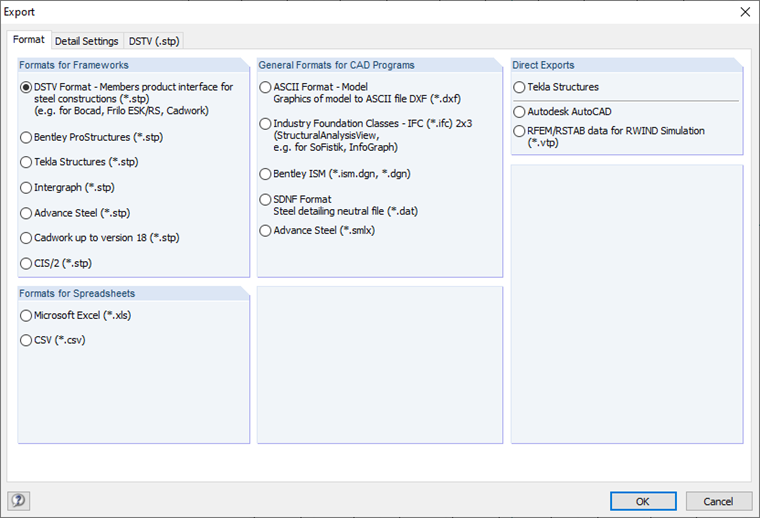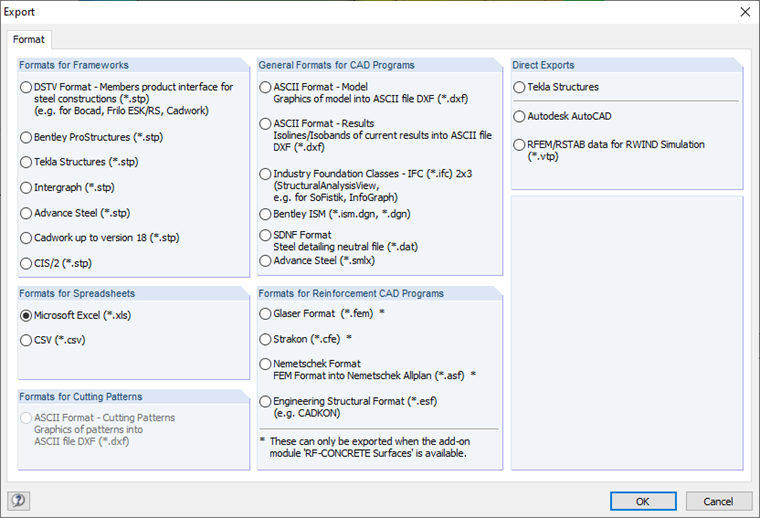Interface Between RFEM/RSTAB and Autodesk Revit
RFEM and RSTAB communicate with Revit Structure via a direct interface and allow for data exchange. Structures modeled with RFEM and RSTAB can be transferred to Revit Structure at the push of a button.
RFEM/RSTAB is based on an object-oriented building model, and Revit on parametric modeling. Thus, the intelligence of the objects is not lost during the data exchange. This means that you get another equivalent object in Revit or RFEM/RSTAB for a column or beam, not just a collection of lines.
Direct RSTAB/RFEM Interface to Autodesk AutoCAD
The members are exported as lines from RFEM/RSTAB. The layers of these lines contain the information about the cross-sections and materials used. When exporting a DXF file from RFEM, it is possible to export the numbering, which is controlled by the navigator, in addition to the entire model - including the FE mesh.
Another option for exporting from RFEM/RSTAB is to transfer the results to a DXF file in the form of isolines. For this, you can specifically select various elements, such as isolines, FE mesh, values, and so on.
Direct RSTAB/RFEM Interface to Tekla Structures
With the directly integrated interface, the analytical model of detailed systems can be transferred easily from Tekla Structures to RFEM/RSTAB.
The Tekla model can be updated quickly using the direct interface by comparing the modified materials, profiles, and coordinates when carrying out modifications in structural engineering. It is also possible to remove the construction elements that no longer exist, or to add new ones.
Interfaces to Rhino & Grasshopper
Rhino Interface: Both lines and surfaces including openings can be exported to or imported from RFEM 6. The following line types can be transferred: line, polyline, arc, circle, ellipse, parabola, and NURBS. Furthermore, it is possible to exchange these surface types: plane, rotated surface, and NURBS.
Grasshopper interface: This interface allows you to activate the Dlubal tab in Grasshopper. This includes three components. The "Surfaces" component allows you to add Dlubal-specific surface properties (material, thickness, surface stiffness type) to 2D geometries. Use the "Member" component to add member-specific properties (material, cross-section, member rotation) to incoming lines or curves. The third component allows direct export to RFEM.
Other Exchange Formats
DXF, IFC, STP (e.g. for Intergraph, Advance Steel, SEMA, Cadwork, HSB-Cad, etc.), DSTV (e.g. for Bocad and Frilo), FEM (Glaser) and CFE (Strakon), XLS (Microsoft EXCEL), CSV, ISM.DGN, DGN (Bentley ISM), DAT, SMLX (Advance Steel), ASF (Nemetschek Allplan), ESF
A detailed overview of the interfaces and the BIM-oriented planning is available on our website: Building Information Modeling (BIM).
Also, there are numerous webinars about BIM that you can watch as videos on our website.

